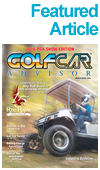Across the country, people are increasingly choosing golf cars as a reliable, convenient, and affordable method of local transportation. It is appealing, especially in regions with favorable, year round weather, for residents to zip around their communities, college campuses, or RV parks in their golf cars. But, what many golf car drivers do not realize is that golf cars were not originally designed for roadway transportation and operating them in an unsafe manner may have fatal consequences.
It is difficult to know, for sure, how many golf car injuries and deaths occur each year since they are not specifically tracked on a national level; however, the Consumer Products Safety Commission estimates that over 15,000 golf car injuries occur in the United States each year. More troubling is that, according to the American Journal of Preventative Medicine, over 30% of those injuries are experienced by children. While it may seem innocent enough (and it is legal in most states) to allow a young teen to operate a golf car, one sharp turn can result in disaster.
Since we are all planning to continue customizing, selling, and driving golf cars, how can we ensure that we remain safe? Following these tips will maximize golf car fun and minimize the risk:
- Drive Responsibly. Keep arms and legs inside of the golf car. Injuries to limbs that are handing outside of the golf car are reportedly one of the top five most common injuries. If the golf car is equipped with seat belts, use them.
- Understand the Terrain. Factory golf cars are built for use on the flat turf that comprises golf courses. If your golf car will be traveling offroad, on trails, or over hills, upgrade your golf car accordingly with aftermarket suspension and custom tires.
- Limit Passengers. Never try to squeeze in extra passengers. Standard golf cars are designed to transport two passengers in the front seat. Golf cars that have a rear seat kit added can accommodate two additional passengers. Make sure that all passengers are safely seated before putting the vehicle into motion.
- Avoid Excessive Speeds. Most communities that permit golf car driving have posted speed limits. When golf cars are operated above 15 miles per hour, they are at an increased risk of being involved in an accident. Sharp turns and sudden starts and stops should also be avoided, as they may increase the risk of the golf car overturning.
- Yield. Be extra cautious for oncoming traffic. Although golf cars are smaller and may be used for recreation, they are still considered to be vehicles, especially when operated on streets among other vehicles. And always yield to pedestrians and follow traffic laws.
- Be Sober and Alert. Just like any other vehicle, golf cars are able to reach speeds that are high enough to require quick reflexes and sound decision making. Although it may be tempting to consume alcoholic beverages while cruising around in your golf car, please remember that golf cars are vehicles and drivers are subject to many of the same penalties as traditional vehicles, including DUIs. If you are taking medications that affect impairment or you would like to enjoy an adult beverage, it is best to give up the driver’s seat to a designated driver.
The commercial use of golf cars has also increased, as they are an efficient method of transportation for groundskeepers, car dealer sales staff, hospital workers, and also within manufacturing plants. If your workplace takes advantage of the convenience and effectiveness of golf car transport, you likely have guidelines that have been established in an attempt to prevent injury. These guidelines may include written safety policies about the ongoing maintenance of the golf cars and specific operating procedures.
Within industrial settings, golf cars may be categorized as heavy equipment and employees are required to be trained prior to golf car operation. Under these circumstances, the training may include the understanding of rules such as:
- Inspect the vehicle prior to use.
- Operate golf cars no faster than 15mph.
- Observe all vehicle traffic laws.
- Slow down and honk the horn at all intersections.
- Place the control lever in the neutral position and remove the key, when the golf car is not in use.
Several universities, such as Stetson, Lander, and USF have mandatory training programs for any staff planning to operate golf cars and a few insurance companies have developed comprehensive training programs designed for corporations.
The increasing popularity of golf cars will inevitably lead to an increase in accidents. By abiding by a few safety rules, we can ensure the use of golf cars within both residential and commercial environments by staying injury free.
Julie Wilson, Owner of WHEELZ Custom Carts & Accessories, was one of the industry’s first online retailers of golf cart parts, when she founded her business in 2008. Julie’s eCommerce store, www.WHEELZLLC.com remains a popular online shopping experience for innovative golf car parts and accessories.




















